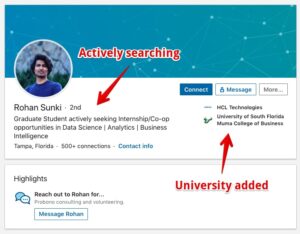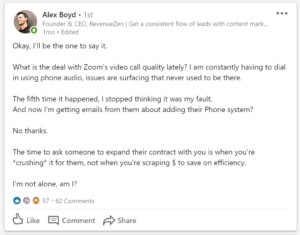How to Make A LinkedIn Profile As a College Student: If you are a college student and you do not have a LinkedIn profile and you want to create a LinkedIn profile, then you have come to the right article.
In today’s article, we are going to know how to make a LinkedIn profile as a college student in 2024. Be it a student, school student or working somewhere and your work is related to digital technology, then you must create your LinkedIn profile.
In today’s digital world, everything is becoming digital and nowadays many companies find employees for their work online. You do not need to go anywhere for the job and your job interview also happens online.
Watch video below If you don’t want to read article
Nowadays everyone is professional in something or the other, some know video editing, some are doing digital marketing, some have done software engineering but are not getting a job, so for all these professional people and for them to get a job. LinkedIn is a very good and professional platform.
But if you are currently studying in college or you are an expert in anything and want to do a job, then LinkedIn is a very right platform for you. If once you create your profile on LinkedIn and optimize the profile well. If you do this and always keep posting something, then you can easily get any work and job on LinkedIn.
Also Read: How much money can earn from facebook reel
So, if you have not created a LinkedIn profile yet, then let us know how to make a LinkedIn profile for college students. Making a profile is not everything, nor will you get a job just by making a profile. We will also have to optimize it well, so let’s start dive into our main topic….
7+ Tips For How To Make LinkedIn Profile Attractive For College Students
LinkedIn is a professional platform and it is a community of professional people and people who want to do jobs can easily find jobs here. But for this, you will have to create a LinkedIn profile and once you have created a LinkedIn profile, you can apply for any job here.
Now after creating your profile, you will have to optimize your profile.
Your skills will also have to be added in the profile and other details like what are you professional in? A good and fully optimized LinkedIn profile will help you create your personal brand and here you can network with professionals just like you. So let’s know how to make LinkedIn profile for freshers?
1. Professional Profile Photo

Your profile photo serves as your first impression, Profiles with photos are 7 times more likely to be viewed. Your profile photo should be a recent professional image, be you on your own, be set against a plain background, have your face in the centre of the frame, be a good quality picture, not blurry, be well lit so your face is visible.
You should choose a profile photo that makes you look professional and your personality should be reflected in the photo. Choose A well-lit, high-resolution headshot against a neutral background In The Profile Photo Avoid using selfies, casual photos, or images with distracting elements.
2. Attention-Grabbing Headline

Your headline is the first thing people see when they view your profile and can influence how potential employers, recruiters, and hiring managers perceive you. List your desired job in your headline.
Your headline should include three parts:
- who you are,
- what you offer,
- and what you’re looking for.
- The first part should convey your professional identity,
- the second part should highlight your unique skills or experience
- and the third part should communicate your professional interests and goals.
3. Professional About Section

Your About section is an excellent way to introduce yourself on LinkedIn and quickly advertise your qualifications. Think of it like the Summary section of your resume and create a brief statement, Add These Things to Your Linkedin About Section –
- Add Your Professional Skills
- 1-2 Sentence About Your Relevant Experience.
- Try adding in keywords and tailoring your skills to employer needs.
- Short Description Of Your Network.
- Some Of Your Education Qualifications.
Also note any words or phrases used by others in your industry to describe their roles. Include as many as possible in both your About and Skills sections.
4. Attractive Cover Picture

Design a LinkedIn cover photo. Your LinkedIn cover photo is one of the BEST ways to get noticed. A cover photo is a great way to show off your personality, outline your industry passions and your key skills.
5. Highlighting Your Educational Background

You have to tell about your education background in details like from which institute you have studied, which degree you have and the date when you completed your graduation, you also have to write your academic projects and what you have done in college. Everything is archived, you have to write.
You also have to write down what goals and targets you have in your future and also list what honors and awards you have received during your academic career.
By including all of this information in your Education section, you can create a comprehensive and informative overview of your educational background that will help potential employers, recruiters, and hiring managers learn more about you and your qualifications.
6. Your Skills And Certificates

Friends, this is the most important thing, you have to add your skills. Whatever skills you have, you have to list them in your profile. What are your soft skills, what are your hard skills and whatever small and big skills you have and your technical skills have to be added in your profile. You have to add them all here. Prioritize skills that are in demand in your target industry and align with your career goals.
And friends, if you have any certificate then list that certificate in your profile along with the skill for which you have got the certificate. Include the name of the certification, issuing organization, and date of completion.
Encourage connections to endorse your skills and provide recommendations. These endorsements and recommendations add credibility and social proof to your profile.
7. Keeping Your Content Fresh and Relevant

You should keep posting and updating regular content on LinkedIn and you should always keep your profile updated. If you are learning any new skill, then you have to add it and whatever new skills you learn and get a certificate, you can also add it. List it in your profile.
Share informative articles, industry news, and personal reflections related to your field. This demonstrates your expertise and engagement with your professional community.
Tips For How To Make Linkedin Profile For College Students
If you want to create a Linkedin Profile, then after creating your profile, the things you should include in it are given below –
● Experience: Add relevant experience only.
● Education: Beef up your Education section.
● Projects: Show your work under Projects.
● Network: Build your network.
● Workshop: Attend a workshop.
● Be active: An active user is someone who publishes articles, collaborates with others on LinkedIn and comments on others posts.
● Cover photo: Design a LinkedIn cover photo. Your LinkedIn cover photo is one of the BEST ways to get noticed. A cover photo is a great way to show off your personality, outline your industry passions and your key skills.
Final Words – How to Make a LinkedIn Profile As a College Student
So guys, in today’s article we have told you how you can create a Linkedin profile and optimize it so that it becomes easier for you to find a job and build a network by doing your personal branding.
So if you have any question then the comment section is always open for you.

